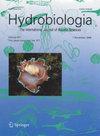Guayas慈鲷(Mesoheros festae)在幼鹿期以棕榈粉为基础的饮食的生产性能
IF 0.3
4区 生物学
Q4 MARINE & FRESHWATER BIOLOGY
引用次数: 1
摘要
背景:随着水产养殖业的不断发展,寻找新的蛋白质饲料来源成为研究的热点。目标:1)试图提供厄瓜多尔一种重要商业物种养殖的第一批数据;2)替代饲料的蛋白质来源,以尽量减少水产养殖中以鱼为基础的饲料的全球问题。方法:采用棕榈饼替代率为0%、4%、8%和12%的4种饵料处理,饲喂瓜亚鱼幼鱼30 d。在实验培养结束时,计算并分析了几种动物技术指标,以及饲料的近似组成。结果:添加8%的棕榈饼对干物质、总蛋白质和总能消化系数无影响。0、4和8%棕榈粕含量处理对终重、生长率、食物转化率、蛋白质效率和蛋白质生产价值均无显著影响。随着饲粮中棕榈仁粕含量的增加,饲料转化率降低。在饮食中增加棕榈粕可以降低成本。结论:在饲粮中添加8%棕榈粕替代棕榈饼不影响生产性能,且饲料生产成本较低。本文章由计算机程序翻译,如有差异,请以英文原文为准。
Productive performance of the Guayas cichlid (Mesoheros festae) fed palm meal based diets during the juvenile stag
Background: The increasingly aquaculture development have favored the searching of new protein sources for fish feeding. Goals: 1) trying to present the first data on the culture of an important commercial species in Ecuador, 2) replacing the protein source for feeding in order to minimize the global problem of the fish-based meals in aquaculture. Methods: Guayas cichlid juvenile fish were submitted to 4 feeding treatments: 0%, 4%, 8% and 12% palm cake replacement for 30 days. Several zootechnnical indexes were calculated and analyzed at the end of the experimental culture, as well as the feed proximal composition. Results: The inclusion up to 8% palm cake did not affect the digestibility coefficients of dry matter, gross protein or gross energy. No differences were found in final weight, growth rate, food conversion rate, protein efficiency rate and productive value of the protein among 0, 4 and 8% palm meal content treatments. As the percentage of palm kernel meal in the diets was increased, the food conversion rate decreased. Increasing palm meal in diets decreased costs. Conclusions: The productive performance was not affected by the palm cake replacement in diets up to 8% with palm meal, and deriving in lower feed production costs.
求助全文
通过发布文献求助,成功后即可免费获取论文全文。
去求助
来源期刊

Hidrobiologica
生物-海洋与淡水生物学
CiteScore
0.40
自引率
0.00%
发文量
8
审稿时长
>12 weeks
期刊介绍:
HIDROBIOLÓGICA es una publicación cuatrimestral que difunde trabajos originales e inéditos de investigación o revisión, sobre temas relacionados con los organismos y la hidrología de los ambientes acuáticos, dulces y marinos y va dirigida a investigadores de todo el mundo, interesados en las diversas disciplinas que incluye la Hidrobiología , así como a alumnos de posgrados y licenciaturas relacionados con la biología, ecología, taxonomía, filogenia y evolución de organismos acuáticos, e hidrología y oceanografía de ambientes s dulceacuícolas y marinos.
 求助内容:
求助内容: 应助结果提醒方式:
应助结果提醒方式:


